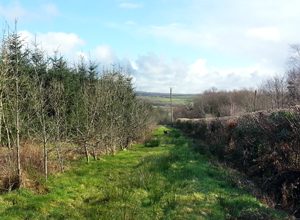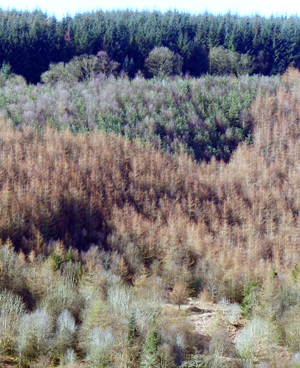20 20 vision for 2020 – is even 20% tree cover enough?

Campaigners say that we need to increase tree cover to 50% and claim it will help deal with climate change. Tree planting became a big issue in the recent general election but it's much harder than people think and probably less effective at combatting climate change than other simpler measures. For a start it's a slow business - even in the 1960s tree-planting splurge it took a decade of feverish activity to increase tree cover by just a few percentage points. Also you need to think carefully about where you plant and what trees you plant - the 1960's planting was mostly on uplands and with mono-cultures that were bad for biodiversity (mainly spruce and pine). More fundamentally we need to ask what this tree-planting is trying to achieve: can the carbon fixed through one crop of trees realistically counter the burning of carbon from millions of generations of trees represented by burning coal and oil?
There is no substitute for reducing carbon consumption and anyway that would be a much easier thing to achieve. A typical Brit consumes/releases 8 tonnes of carbon per year and obviously this isn't evenly distributed - the middle classes consume much more, in line with their wealthier lifestyles. That compares with poorer African countries where consumption is a small fraction - a Somali produces less than a tenth of a tonne of carbon each year - so a Brit's consumption every 4 days is about the same as a Somali for a whole year. A typical Pakistani has a carbon footprint of only a tenth of the average British person. We need to cut consumption much more urgently than we need to plant trees.
 Anyway, let's see how tree-planting in the UK might help. According to the Forestry Commission there are about 3 million hectares of trees in the UK representing about 13% tree cover (more in Scotland and less in England). Suppose we were to double that to 6 million hectares, how much carbon would the extra trees fix? Assume an average "yield class" of 10, which means that each hectare adds 10 tonnes per year, this would fix a maximum of an extra 30 million tonnes of carbon each year - assuming you never fell the trees and that you opt for continuous cover management. So that represents a maximum of half a tonne per UK citizen per year while we are consuming about 8 tonnes. It would also be an enormous upheaval to plant that many trees in a short time.
Anyway, let's see how tree-planting in the UK might help. According to the Forestry Commission there are about 3 million hectares of trees in the UK representing about 13% tree cover (more in Scotland and less in England). Suppose we were to double that to 6 million hectares, how much carbon would the extra trees fix? Assume an average "yield class" of 10, which means that each hectare adds 10 tonnes per year, this would fix a maximum of an extra 30 million tonnes of carbon each year - assuming you never fell the trees and that you opt for continuous cover management. So that represents a maximum of half a tonne per UK citizen per year while we are consuming about 8 tonnes. It would also be an enormous upheaval to plant that many trees in a short time.
Whilst some more centrally-planned tree planting is a probably a good thing here are three simple, but controversial, ways to increase carbon fixing through forestry and agriculture:
- remove the subsidies for sheep farming. There are far too many sheep, they do little else apart from eating and they stop the natural regeneration of trees on millions of acres of hillside - which will happen in their absence. You'll get more trees without having to plant them and with natural regeneration they will grow where they "want to be"
 reform the tax rules than make all timber income tax-free. This concession was introduced under Margaret Thatcher and has the effect of encouraging forest owners to clear-fell their forests and to do it much too early. This rule could be replaced by limiting the tax break on felled timber to only apply to woodlands that have "continuous cover". This could be accompanied by tax breaks for money spent on new planting.
reform the tax rules than make all timber income tax-free. This concession was introduced under Margaret Thatcher and has the effect of encouraging forest owners to clear-fell their forests and to do it much too early. This rule could be replaced by limiting the tax break on felled timber to only apply to woodlands that have "continuous cover". This could be accompanied by tax breaks for money spent on new planting.- refuse to give farming subsidies [of any sort] to farms which have less than 10% tree cover. Obviously this would be phased in and farmers would need to be given plenty of support in getting new shelter belts and copses established.
Along with other measures that are being introduced this would increase tree-cover and boost the carbon fixing of existing ones. By the end of the 2020s we could have 20% tree cover, but there is still no excuse for not reducing our excessive carbon consumption in the UK.
Comments are closed for this post.
Discussion
Thank you; that’s very thought-provoking.
An aside, but can you please clarify why continuous cover, with say 100 trees taken a year, should be any different in its carbon cost compared to a coppicing regime with a coupe of 100 trees a year?
In terms of its ability to regenerate, I’d have thought the coupe far more productive than 100 single-tree gaps.

Very good summary of the problem we face as a developed society and the questions which arise out of headline, knee-jerk solutions. Your comments ought to reach a wider audience.
But, as you say, it will all take years for arboreal counter-measures to become effective and there needs to be something progressing today; so your last sentence has real value.
Don J
10 January, 2020